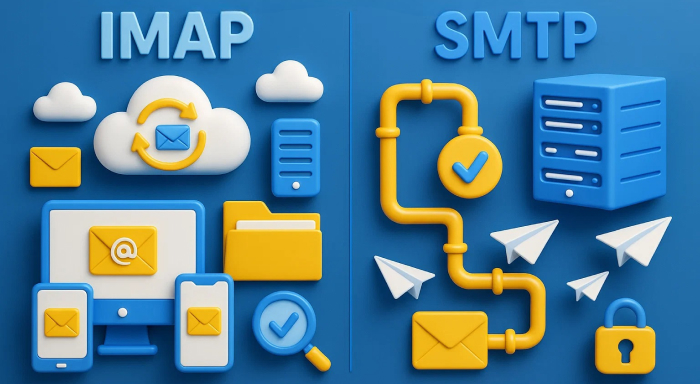In today’s digital age, email remains a cornerstone of communication. Whether you’re setting up a personal email client or managing a business’s email infrastructure, understanding the protocols that govern email transmission and retrieval is crucial. Two primary protocols at play are SMTP and IMAP. While they often work in tandem, they serve distinct purposes. Let’s delve into the differences between SMTP and IMAP, their functionalities, and how they impact your email experience.
What is SMTP?
SMTP, or Simple Mail Transfer Protocol, is the standard protocol used for sending emails across networks. Established in the early 1980s, SMTP facilitates the transmission of outgoing emails from a client to a server or between servers.
Key Features of SMTP:
-
Purpose: Designed specifically for sending emails.
-
Operation: Transfers emails from the sender’s device to the recipient’s mail server.
-
Ports Used:
-
Port 25: Traditionally used for SMTP communication between mail servers.
-
Port 465: Used for SMTP over SSL (SMTPS).
-
Port 587: Preferred for email client submission with STARTTLS encryption.
-
-
Security: Supports encryption methods like SSL/TLS to secure email transmission.
How SMTP Works:
When you send an email:
-
Your email client connects to the SMTP server.
-
The SMTP server processes the recipient’s email address.
-
It determines the recipient’s mail server and transfers the email.
-
If the recipient’s server is unavailable, SMTP queues the message for later delivery.
What is IMAP?
IMAP, or Internet Message Access Protocol, is used for retrieving and managing emails stored on a mail server. Introduced in 1986, IMAP allows users to access their emails from multiple devices, ensuring synchronization across platforms.
Key Features of IMAP:
-
Purpose: Designed for retrieving and managing emails.
-
Operation: Allows users to view and manipulate emails stored on the server without downloading them.
-
Ports Used:
-
Port 143: Default port for IMAP without encryption.
-
Port 993: Used for IMAP over SSL/TLS (IMAPS).
-
-
Synchronization: Changes made (like reading or deleting an email) are reflected across all devices accessing the account.
How IMAP Works:
When you check your email:
-
Your email client connects to the IMAP server.
-
The server displays the emails stored.
-
Actions like reading, deleting, or organizing emails are performed on the server.
-
These actions are synchronized across all devices accessing the email account.
SMTP vs IMAP: A Comparative Overview
| Feature | SMTP | IMAP |
|---|---|---|
| Primary Function | Sending emails | Retrieving and managing emails |
| Direction | Outgoing mail | Incoming mail |
| Device Synchronization | Not applicable | Synchronizes across multiple devices |
| Email Storage | Does not store emails | Stores emails on the server |
| Ports Used | 25, 465 (SSL), 587 (STARTTLS) | 143 (default), 993 (SSL/TLS) |
| Security | Supports SSL/TLS encryption | Supports SSL/TLS encryption |
| Use Case | Sending emails from client to server | Accessing and managing emails on the server |
When to Use SMTP and IMAP
-
SMTP is exclusively used for sending emails. Whenever an email is dispatched from your client, SMTP handles its transmission.
-
IMAP is employed when you want to access, read, or manage your emails stored on the server, especially from multiple devices.
Note: Most email clients are configured to use both protocols—SMTP for sending emails and IMAP for receiving them.
Real-World Scenario
Imagine you’re using an email client like Outlook or Thunderbird:
-
When you compose and send an email, SMTP is the protocol that ensures your message reaches the recipient.
-
When you check your inbox, IMAP allows you to view and manage your emails stored on the server, ensuring that any action you take (like reading or deleting an email) is synchronized across all your devices.
Security Considerations
Both SMTP and IMAP support encryption methods to secure email data:
-
SSL/TLS Encryption: Ensures that the data transmitted between your client and the server is encrypted, protecting it from potential eavesdropping.
-
Authentication Mechanisms: Both protocols support various authentication methods to verify user identities and prevent unauthorized access.
Best Practices:
-
Always use encrypted ports (465 for SMTP, 993 for IMAP) to enhance security.
-
Regularly update your email client to the latest version to benefit from security patches.
-
Use strong, unique passwords and consider enabling two-factor authentication if supported.
Conclusion
Understanding the roles of SMTP and IMAP is essential for efficient and secure email communication. While SMTP handles the sending of emails, IMAP manages the retrieval and organization of incoming messages. Together, they ensure a seamless email experience across devices.
By configuring your email client correctly and adhering to security best practices, you can leverage the strengths of both protocols to maintain effective and secure communication.
